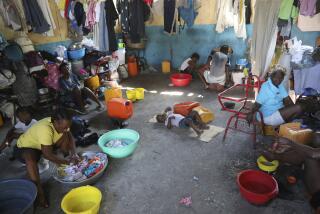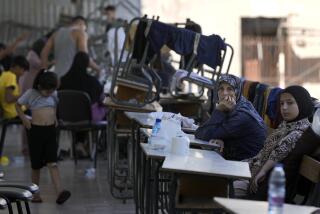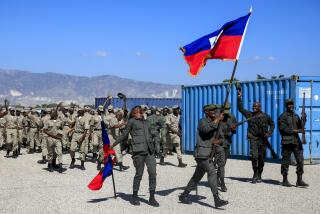Haiti quake response largely a success
Reporting from Port-Au-Prince, Haiti — The numbers were apocalyptic: More than 220,000 people killed and 300,000 injured. Over 1 million people displaced from homes. About 280,000 houses either obliterated or damaged. An estimated 25 million cubic yards of rubble to be cleared, much of it from the narrow, congested streets of Port-au-Prince.
Add to that a crippled government, its ministry buildings and presidential palace destroyed. And in a bitter coup de grace, aid organizations already working in Haiti before the Jan. 12 earthquake were left reeling, most notably the United Nations, which lost its top two officials and more than 80 others.
“When in the past have we ever had a catastrophe like this one, in which the capital of a country and its government has essentially disappeared?” said Gerard Gomez, a top humanitarian aid advisor to the U.N. leadership in Haiti.
Given those challenges, where does the relief effort stand two months after the quake? On two crucial fronts, it has been, broadly speaking, a success story. But on others, results have been far more mixed.
The ability to relatively quickly disburse large amounts of food and water and provide medical treatment, aid officials said, tamped down the potential for widespread panic and chaos in the streets of Port-au-Prince and elsewhere.
“There has been no rioting over food, and we avoided people dying of hunger or thirst,” Gomez said. “This is no small accomplishment.”
Progress has been considerably slower on shelter and sanitation issues, aid officials acknowledged, raising fears among experts of a second crisis when the region’s torrential seasonal rains arrive in coming weeks.
The uneven pace at which aid has been delivered has also been a problem, as aid workers have struggled to map and reach the 400 or so tent camps that have popped up in and around the capital. Pockets of the city and many needy areas in its environs have gone unserved for weeks.
“We’re not talking about reaching 1,000 people. We’re talking about more than a million people, who are not all in one place, but who are in hundreds and hundreds of spontaneous camps,” Gomez said. “It takes time. It takes plenty of time.”
A recent report by Refugees International was critical of what it said was poor oversight of the relief effort by top U.N. officials in Haiti and the world body’s ineffective coordination with local aid groups.
With so many groups working at varying levels of coordination, it is impossible to assess all aspects of the relief effort in Haiti, but markers of progress can be laid down on key issues being addressed on a large scale by the United Nations and other leading organizations.
Medical care
With countless people trapped alive in buildings and thousands suffering from crushed limbs, head trauma and other injuries, rescue operations and medical care were the first focus of the relief push.
Several search-and-rescue teams from the United States, France and elsewhere had arrived within a day or two of the quake, and more than 200 people trapped in collapsed buildings were saved, according to a U.N. tally.
And, although it certainly did not arrive in time for an unknown number who died before receiving attention, the medical response was also relatively swift, as teams of doctors and nurses from several countries fanned out across the city and other affected areas.
The University of Miami, for example, erected a field hospital on the airport grounds, where several hundred of the most seriously injured were treated. The U.S. military sent a hospital ship and other medical personnel, who treated about 5,000 of the injured, U.S. government officials reported.
Food and water
In the chaotic first two weeks after the quake, the U.N.’s World Food Program oversaw emergency handouts of military-style ready-to-eat meals and high-energy biscuits. On Feb. 1, the agency switched to a more orderly, daily distribution of two-week rice rations from 16 locations in the capital.
The decision to deliver only rice instead of adding oil, beans and other foodstuffs was deliberate, said Claude Jibidar, interim director in Haiti for the World Food Program, because the grain is a staple of the Haitian diet and could be imported and distributed quickly. The huge influx of rice also served to stabilize the skyrocketing prices being charged at markets in the wake of the quake, he said. At a rice handout early one morning last month, several hundred women stood pressed together for hours in a line that snaked down a street near the collapsed presidential palace. (In an effort to avoid rioting or fighting in distribution lines, only women were allowed to receive rice.)
Except for some jostling in line, the process went smoothly as a few dozen women at a time were admitted into the gated distribution area. As at all of the rice handouts, several armed U.N. peacekeeping soldiers kept watch from military vehicles and nearby rooftops.
The handout program, which lasted three weeks, provided rice for about 2.5 million people, WFP officials said.
The International Committee of the Red Cross and other aid groups, meanwhile, led the push to disseminate a steady supply of drinking water to about 850,000 people, according to U.N. figures. Many of the settlement camps have been equipped with large rubber bladders that are filled regularly from water trucks.
“It has worked,” Jibidar said. “It is one of the clearer examples we can point to that demonstrates the ability of the humanitarian community to actually help and get something significant out to the people quickly.”
Shelter, sanitation
Things have gone less quickly on issues of shelter and sanitation in the several hundred camps. With the rainy season coming, aid officials readily acknowledge that they are in a race against the clock.
About 185,000 tarpaulins or tents have been handed out, according to U.N. figures released last week, enough to provide shelter to only about 40% of the people in need. The relief effort is lagging even further in the increasingly frantic push to dig a sufficient number of latrines or install portable toilets in the hundreds of camps.
The unsanitary conditions, experts fear, could lead to an explosion of disease when the rains arrive. Of the roughly 21,500 latrines needed to meet minimum health standards, only about 2,800 had been dug five weeks after the quake, according to the most recent U.N. figures. A planned shipment by the U.S. government of 3,000 portable toilets is still weeks away.
The sheer number of tent settlements in and around Port-au-Prince has also overwhelmed aid groups’ ability to reach people at an even pace.
The discrepancy was on display last month along a short stretch of road in the capital. At one end was the sprawling campus of the St. Louis Gonzaga private school, where more than 10,000 Haitians are living. Families at the well-organized camp were among the first to receive rice, and almost all had been given a spacious, sturdy tent. Fresh drinking water has been delivered regularly.
A mile away, however, down a small side street that goes suddenly from paved to dirt, about 750 Haitians were living in a rock-strewn clearing and, a little farther beyond them, 250 or so more had settled on a small scrap of land.
The only outward sign of contact by relief organizations at the two scruffy camps was a large water bladder on the edge of one of them that is refilled periodically. No tents or plastic tarps had been distributed, so families have been left to cobble together flimsy shelters from bedsheets, scrap metal and plastic held aloft by wooden sticks.
“There are going to be pockets of need that are going to take time to permeate,” said Lewis Lucke, who is coordinating the relief effort in Haiti by the U.S. Agency for International Development. “Today is better than yesterday, and tomorrow will be better than today.”
More to Read
Sign up for Essential California
The most important California stories and recommendations in your inbox every morning.
You may occasionally receive promotional content from the Los Angeles Times.











